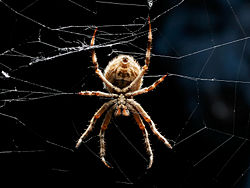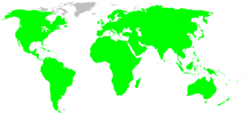Orb-weaver spider
| Orb weaver spider | ||||||||||||||
|---|---|---|---|---|---|---|---|---|---|---|---|---|---|---|
 Eriophora transmarina from Australia
|
||||||||||||||
| Scientific classification | ||||||||||||||
|
||||||||||||||
| Diversity | ||||||||||||||
| 166 genera, c. 2,700 species | ||||||||||||||
 |
||||||||||||||
| Genera | ||||||||||||||
|
Aculepeira |
The orb-weaver spiders (family Araneidae) are the builders of spiral wheel-shaped webs often found in gardens, fields and forests. Their common name is taken from the round shape of this typical web. Orb-weavers have eight similar eyes, legs hairy or spiny and no stridulating organs. The family is cosmopolitan, including many well-known large or brightly colored garden spiders. There are more than 2800 species in over 160 genera worldwide, making this the third largest family of spiders known (behind Salticidae and Linyphiidae).
Contents |
The orb-web
Generally, orb-weaving spiders are three-clawed builders of flat webs with sticky spiral capture silk. The building of a web is an engineering feat, begun when the spider floats a line on the wind to another surface. The spider secures the line and then drops another line from the center, making a "Y". The rest of the scaffolding follows with many radii of non-sticky silk being constructed before a final spiral of sticky capture silk. The third claw is used to walk on the non-sticky part of the web. Characteristically, the prey insect that blunders into the sticky lines is stunned by a quick bite and then wrapped in silk. If the prey is a venomous insect, such as a wasp, wrapping may precede biting.

Some "orb-weavers" do not build webs at all. Members of the genera Mastophora in the Americas, Cladomelea in Africa and Ordgarius in Australia produce sticky globules, which contain a pheromone analog. The globule is hung from a silken thread dangled by the spider from its front legs. The pheromone analog attracts male moths of only a few species. These get stuck on the globule and are reeled in to be eaten. Interestingly, both types of bolas spiders are highly camouflaged and difficult to locate.
The spiny orb-weaving spiders in the genera Gasteracantha and Micrathena look like plant seeds or thorns hanging in their orb-webs. Some species of Gasteracantha have very long horn-like spines protruding from their abdomens.
One feature of the webs of some orb-weavers is the stabilimentum, a crisscross band of silk through the center of the web. It is found in a number of genera, but Argiope, which includes the common garden spider of Europe as well as the yellow and banded garden spiders of North America, is a prime example. The band has been hypothesized to be a lure for prey, a marker to warn birds away from the web and a camouflage for the spider when it sits in the center of the web.
Most arachnid webs are vertical and the spiders usually hang with their head downward. A few webs, such as those of orb-weaver in the genus Metepiera have the orb hidden within a tangled space of web. Some Metepiera are semi-social and live in communal webs. In Mexico such communal webs have been cut out of trees or bushes and used for living fly paper.
Natural history
The oldest knowns true orb-weaver is Mesozygiella dunlopi, from the Lower Cretaceous. Several fossils provide direct evidence that the three major orb weaving families, namely Araneidae, Tetragnathidae and Uloboridae, had evolved by this time, about 140 million years ago. They probably originated during the Jurassic (200-140 million years ago). All three families very likely have a common origin.[1]
Systematics
The categorization into subfamilies and tribes follows Joel Hallan's Biology Catalog.
The Nephilidae have been elevated to family status in 2006. Some researchers also consider the genera Leviellus, Parazygiella, Stroemiellus and Zygiella to reside in the family Zygiellidae.
- Araneinae Simon, 1895
-
- Anepsiini
- Arachnurini
- Araneini
- Arkycini
- Bertranini
- Celaenini
- Cyclosini
- Dolophonini
- Exechocentrini
- Heterognathini
- Hypognathini
- Mangorini
- Poltyini
- Pseudartonini
- Testudinarini
- Ursini
- incertae sedis
- Glyptogona Simon, 1884
- Argiopinae
- Cyrtarachninae Simon
-
- Cyrtarachnini Simon
- Mastophorini
- Cyrtophorinae
- Gasteracanthinae
-
- Caerostrini
- Gasteracanthini
- Micratheninae
- incertae sedis
-
-
- Artonis Simon, 1895
- Colphepeira Archer, 1941
- Enacrosoma Mello-Leitão, 1932
- Encyosaccus Simon, 1895
- Melychiopharis Simon, 1895
- Micrepeira Schenkel, 1953
- Parmatergus Emerit, 1994
- Pronous Keyserling, 1881
- Sedasta Simon, 1894
- Singafrotypa Benoit, 1962
- Tethneus Scudder, 1890 † (fossil, oligocene)
-
- Tethneus guyoti (Scudder, 1890) †
- Tethneus henzii (Scudder) †
- Tethneus robustus (Petrunkevitch) †
-
Gallery
See also
- List of Araneidae species
- Spider families
Footnotes
- ↑ Penney & Ortuño 2006
References
- The Life of the Spider by John Crompton. Mentor, 1950.
- "The Orb-Weaving Spiders of Canada and Alaska. Araneae: Uloboridae, Tetragnathidae, Araneidae, Theridiosomatidae. Insects and Arachnids of Canada Series, Part 23." By C.D. Dondale, J.H. Redner, P. Paquin, and H.W. Levi. NRC Research Press, Ottawa, 2003. ISBN 978-0-660-18898-0
- How to Know the Spiders by B. J. Kaston. Dubuque, 1953.
- Spiders by Barbara York Main. Sidney, 1976.
- Biology of Spiders, by Rainer F. Foelix, second edition, 1996
- Levi, H.W. (1993): The new orb-weaver genus Lewisepeira (Araneae: Araneidae). Psyche 100: 127-136. PDF
- Penney, David & Ortuño, Vicente M. (2006): Oldest true orb-weaving spider (Araneae: Araneidae). Biology Letters 2: 447-450. doi:10.1098/rsbl.2006.0506 - PDF
- Platnick, Norman I. (2008): The world spider catalog, version 8.5. American Museum of Natural History.
External links
- Spiders of Australia
- Spiders of NW-Europe
- Arachnology Home Pages: Araneae
- World Spider Catalog
- University of Kentucky--Orb Weavers of Kentucky
- Pictures of Mangora species (free for noncommercial use)
- Gasteracantha cancriformis, spinybacked orbweaver on the UF / IFAS Featured Creatures Web site
- Neoscona crucifera and N. domiciliorum on the UF / IFAS Featured Creatures Web site
|
|||||||||||